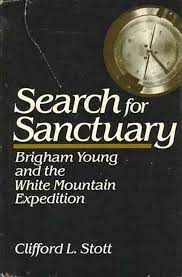Articles/Essays – Volume 18, No. 4
To Search With No Reward | Clifford L. Stott, Search for Sanctuary: Brigham Young and the White Mountain Expedition
Search for Sanctuary received the 1985 Francis M. Chipman Award from the Mormon History Association. A historical narrative, it describes a little-known aspect of the 1857-58 Utah War. Brigham Young sent men out to discover a wilderness fast ness to which the Mormon people might flee to escape an expected onslaught of hostile Gentiles.
Clifford L. Stott, in his first major historical work, prefaces his description of this expedition by describing the political environment in Utah in 1857 and the preceeding years. He tells of the Mormon in transigence to federal rule which prompted President James Buchanan to send Johnston’s Army to Utah. Brigham Young’s initial counter-response to the army was a stance of armed defense later replaced by guerrilla harassment. Then during the winter of 1857-58, Young’s policy of resistance gave way to a policy of retreat. He ordered an exodus of settlers from their northern Utah homes to places south of Salt Lake City, leaving nothing of worth behind.
Simultaneously, Young ordered an expedition to locate a suitable place for re settlement in the unexplored deserts about 200 miles southwest of Salt Lake City. A speculative 1848 map by John C. Fremont, which positioned a mountain range running east-west in the area, fostered Young’s expectation that such a place existed. Mis information about the potential of the area for settlement had also been supplied by Elijah Barney Ward, a mountain man friend of Young’s since the early 1850s.
The description of this exploration forms the core of Search for Sanctuary and is the book’s contribution to Mormon and Utah historical literature. Stott uses previously neglected primary source material for his research, such as the expedition’s official log and manuscript maps and several first hand journal accounts. He also retraced personally parts of the exploration route.
From his study, he concludes that between April and June 1858, the LDS Church carried out the largest exploration effort it had ever mounted. More than 160 men traversed previously unexplored valleys, canyons, and mountains of south western Utah and southeastern Nevada looking for arable land, water, forage, and timber. William H. Dame and George W. Bean commanded two separate parties that traveled more than 2,000 miles, attempted four settlements, and named many of the major features of the landscape.
Yet the impact of this exploratory effort was nearly inconsequential to the general course of both Utah and Mormon history. The explorers were sent on their way by Brigham Young, separated in time and space from the evolving events in Salt Lake City. By late April, Alfred Cumming, the newly appointed territorial governor, intervened to resolve peacefully the differences between the Mormons and the federal troops poised on the borders of Utah. The Mormons moving south returned to their homes, and there was no longer a need for resettlement.
By mid-May, to add disappointment to inconsequence, the explorers, who had continued their reconnoitering of the desert, reached a dismal conclusion. There was no east-west mountain range; there were no sizable rivers; there was no place for pos sizeable rivers; there was no place for pos thousand acres explored in the central Great Basin, only a minute fraction (170 acres) were of even marginal agricultural use, a conclusion remarkably similar to that of John Wesley Powell in 1879.
Optimistically, expedition leaders tried to establish agricultural settlements at the most promising isolated oases; but by late summer 1858, these had withered and the men had been recalled.
In the same way, even the geographic names given by the expedition also disappeared over time. With only a few exceptions—which Stott notes—did any names survive on later federal maps.
No sanctuary, settlement, nor nomenclature resulted from the 1858 White Mountain Expedition. The official reports went unpublicized and even the leaders (Bean served as a guide for Captain James H. Simpson’s exploration of a wagon route to Carson City two years later) failed to pass on the knowledge they had gained of the area.
So, why did Stott write about the great potentials of what might have been? Why be concerned with the struggles of discovery in a hostile environment when in both the short and long terms this struggle came to nearly nothing? Stott recognizes this inconsequence and simply notes in his preface “it is an interesting story and needs to be told, if for no other reason.” It is, indeed, an interesting story of the faith of several men who saw themselves, at the prophet’s request, building the kingdom by seeking a new resting place.
Search for Sanctuary is a history of a backwater, an eddy in the larger flow of surrounding events. The course of the Utah War was unaffected by the outcome of the White Mountain Expedition; later the miners and ranchers who settled the area remembered only rumors of the earlier findings. The discoveries of the Dame and Bean parties were never publicized until this present publication. Stott writes very well; his lengthy narrative is readable and extremely well documented. It follows closely the canons of historical form. But the meaning of the events as he describes them in Search for Sanctuary makes his study as historical writing an examination of fascinating potentials which unfortunately never materialized.
Search for Sanctuary: Brigham Young and the White Mountain Expedition by Clifford L. Stott (Salt Lake City: University of Utah Press, 1984), xiii, 297 pp., $19.95.


 Back to full Issue
Back to full Issue

